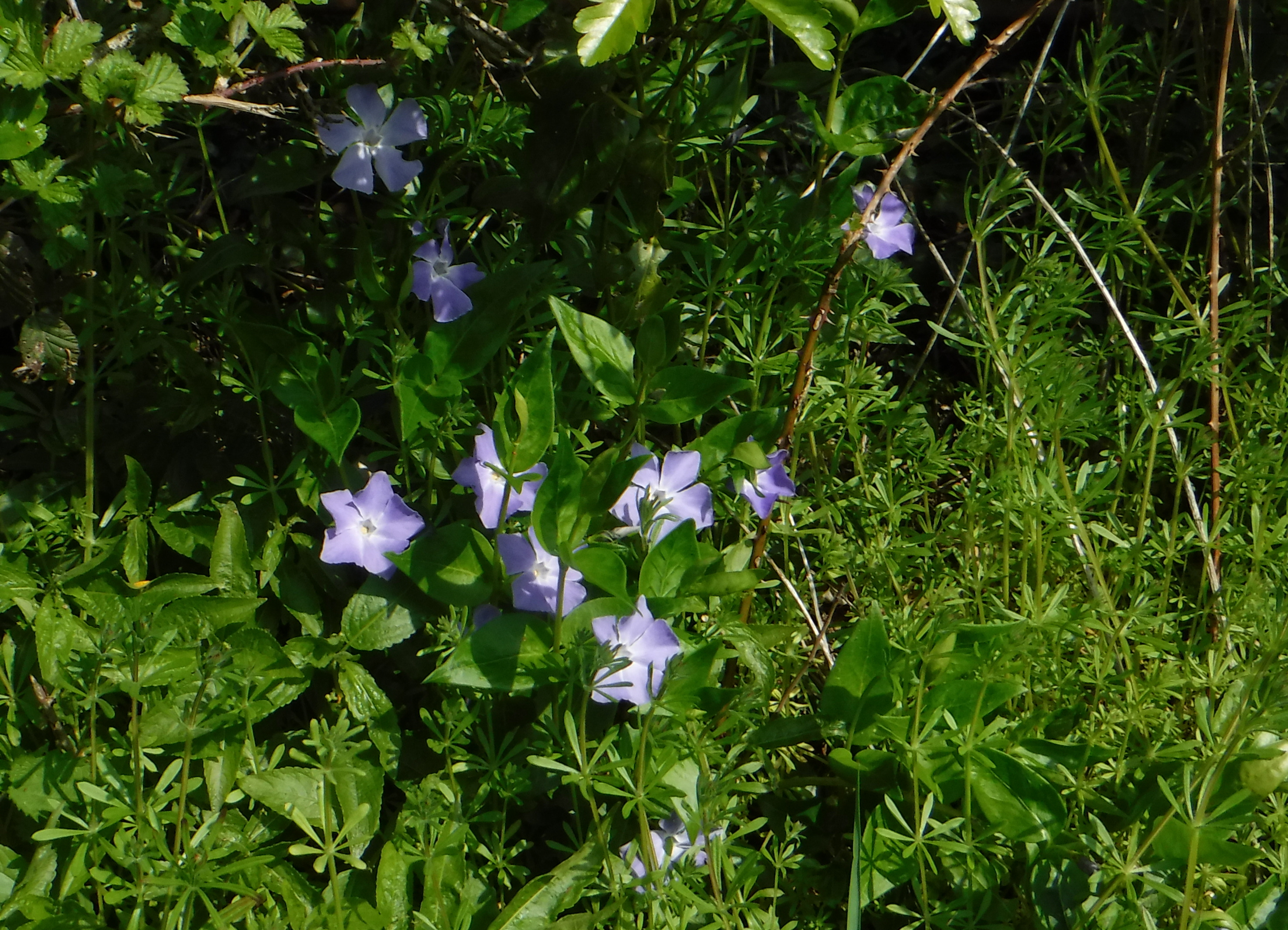
Total monthly rainfall was 22.8 mm with a maximum daily rainfall of 6 mm on 9th April. There were 10 days when measurable rainfall occurred, and 13 days when cloud-cover was 100% for at least part of the day. Rainfall was much lower than daily forecasts suggested because most of the showers avoided our area. Maximum temperature reached 23°C on April 21st amid a warm spell between the 18th and 23rd, and only reached 10°C on the 9th and 14th. A strong wind-chill was present during this latter period, and returned again between the 25th and 28th.
Wildflowers which bloomed began with periwinkle in the front garden hedge on the 1st, followed by greater stitchwort among the woodland bluebells on the 5th. Ground ivy began to make a huge display in the fields on the 7th, while we were astonished to discover four snake’s head fritillaries beside the pond at the end of our garden on the 10th, a new record for us. The first of our wild white bluebells flowered in the wood on the 13th, before common cow parsley along our verge on the 18th. Finally, herb Robert appeared on the 26th to bring the year’s total to 20 species.
-

-
 Lunar thorn moth
Lunar thorn moth
Lunar thorn moth
Lunar thorn moth
-
 Pale prominent moth
Pale prominent moth
Pale prominent moth
Pale prominent moth
-
 Periwinkle
Periwinkle
Periwinkle
Periwinkle
-
 Snakeshead fritillary
Snakeshead fritillary
Snakeshead fritillary
Snakeshead fritillary
-
 White bluebells among the blue
White bluebells among the blue
White bluebells among the blue
White bluebells among the blue
https://www.kentfieldclub.org.uk/news/little-barton-farm-wildlife-notes/april-2019#sigProIdd9815a3389
With two butterfly species appearing this month, green-veined white among hornbeam on the 18th and holly blue in the garden on the 19th, our butterfly species-total rose to 9 for the year so far. An additional six moth-related species brought these also to 9. First were green-oak tortrix caterpillars (food for fledgling blue tits) on the 11th, which produced so many dangling from our woodland trees that we had to search each other’s coats to avoid caterpillars climbing up the walls above our clothes pegs when we went indoors! The remaining five were a micro-moth Agonopterix arenella to light on an indoor wall (19th), the longhorn moth Adela reamurella on and around the hazelnut bushes in the woodland ride (19th), a pale prominent moth to light on a bathroom rug (20th), a muslin moth hiding among grasses in one of our fields (22nd), and a lunar thorn moth on a lighted porch-door on the 28th. Both the pale prominent and lunar thorn are new records for our site.
Many other insect-species appeared this month. On the 15th we spotted a common carder bee on deadnettle, while on the 16th there was an alder fly on pond rush and several pond-skaters on the water-surface. A hawthorn bush revealed a lacewing on the 18th, and some lake-side soft rush harboured the first of the many crane-flies to follow (this one Tipula maxima). The only damselfly to appear was the large red damselfly from our garden pond on the 20th, where we saw several over the next few days, and collected some exuviae. Three days ahead of its Saints Day, the St Mark’s flies appeared around oaks, hazel, and wild cherry on the 22nd. There were over 500 by the 30th.
There were four new wild bird species this month. The chiffchaff arrived about a week late on April 2nd, followed by the wood warbler on the 10th (this identified by checking ‘Birdsongs UK’). The cuckoo (17th) and swallow (19th) were much easier to identify as the former announces itself unmistakably and the latter nests with us every year. Both were slightly late.
Frog tadpoles were formed by the 13th, two minute baby slow-worms were found under a reptile shelter on the 24th. Wild rabbits produced sightings on 5 days of the month, before we spotted a baby rabbit on the lawn on the 29th, and confirmed an active burrow on the 30th. It seems likely that rabbit sightings should pick-up from now on.
Spring progress of trees and shrubs:
Budburst - poplar (7th), oak (12th), beech (18th).
Leafing – field maple (3rd), goat willow (6th), horse chestnut (8th), poplar (15th), oak (18th), beech (21st), ash (22nd).
Flowering – hawthorn (22nd), oak (25th), horse chestnut (29th).
Terry and Susan Dove (with thanks to Keith Palmer for identifying the Pale prominent moth).

